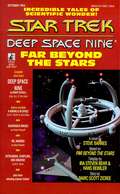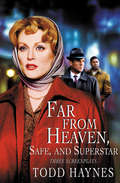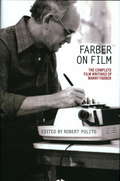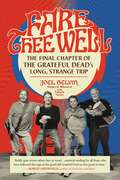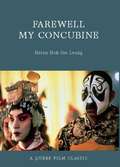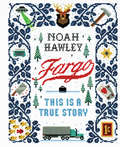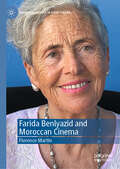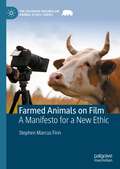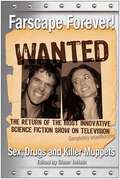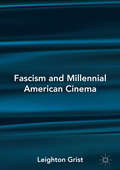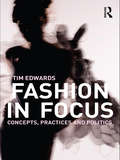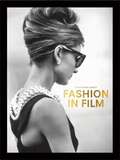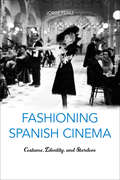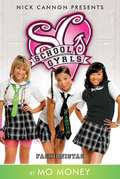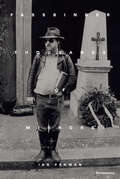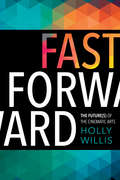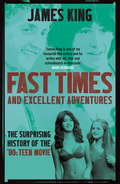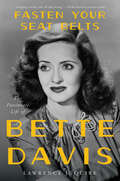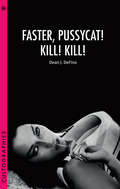- Table View
- List View
Far Beyond The Stars (Star Trek)
by Steven BarnesWithout warning, Benjamin Sisko is living another life. No longer a Starfleet captain, commander of space station Deep Space Nine, he is Benny Russell, a struggling science fiction writer living in 1950s Harlem. Benny has a dream, of a place called Deep Space Nine and a man named Ben Sisko, and a story he has to tell. But is the Earth of that era ready for a black science fiction hero? Everyone tells him no, but Benny cannot abandon his dream. One way or another, he will tell the world about Captain Benjamin Sisko and Deep Space Nine.
Far From Heaven, Safe, and Superstar: Three Screenplays
by Todd HaynesThree acclaimed screenplays from one of today’s most provocative filmmakers, including the Oscar nominated screenplay Far from Heaven. An award-winning auteur and a pioneer of the New Queer Cinema movement, Todd Haynes has achieved both critical acclaim and box office success with his original, intelligent, and often controversial films. Collected here are three of his most celebrated screenplays. Far from Heaven: Winning fifty critics’ prizes and appearing on two hundred Top Ten lists, Far from Heaven was also nominated for four Academy Awards. Inspired by the films of Douglas Sirk, it tells the story of a 1950s housewife who is alienated by her neighbors when she pursues an affair with her African American gardener after learning of her husband’s homosexuality. Safe: Haynes’s breakthrough feature was voted Best Film of the 1990s by the Village Voice Film Critics Poll. It tells the disturbing story of an affluent suburban housewife whose life is shattered by a mysterious illness. One character suggests that perhaps she is “allergic to the twentieth century.” Superstar: The Karen Carpenter Story: Told with a cast of Barbie dolls, this short film about Karen Carpenter’s battle with anorexia was named one of Entertainment Weekly’s Top 50 Cult Movies in 2003. Though the film was ordered destroyed after a lawsuit by the Carpenter estate, it remains an underground classic and “the most talked-about, least-seen film of the ’80s” (The A.V. Club).
Farber on Film: The Complete Film Writings of Manny Faber
by Robert Polito Manny FarberManny Farber (1917-2008) was a unique figure among American movie critics. <P><P>Champion of what he called "termite art" (focused, often eccentric virtuosity as opposed to "white elephant" monumentality), master of a one-of-a-kind prose style whose jazz-like phrasing and incandescent twists and turns made every review an adventure, he has long been revered by his peers. Susan Sontag called him "the liveliest, smartest, most original film critic this country ever produced"; for Peter Bogdanovich, he was "razor-sharp in his perceptions" and "never less than brilliant as a writer."Farber was an early discoverer of many filmmakers later acclaimed as American masters: Val Lewton, Preston Sturges, Samuel Fuller, Raoul Walsh, Anthony Mann. A prodigiously gifted painter himself, he brought to his writing an artist's eye for what was on the screen. Alert to any filmmaker, no matter how marginal or unsung, who was "doing go-for-broke art and not caring what comes of it," he was uncompromising in his contempt for pretension and trendiness, for, as he put it, directors who "pin the viewer to the wall and slug him with wet towels of artiness and significance." The excitement of his criticism, however, has less to do with his particular likes and dislikes than with the quality of attention he paid to each film as it unfolds, to the "chains of rapport and intimate knowledge" in its moment-to-moment reality. To transcribe that knowledge he created a prose that, in Robert Polito's words, allows for "oddities, muddles, crises, contradictions, dead ends, multiple alternatives, and divergent vistas." The result is critical essays that are themselves works of art. Farber on Film brings together this extraordinary body of work in its entirety for the first time, from his early and previously uncollected weekly reviews for The New Republic and The Nation to his brilliant later essays (some written in collaboration with his wife Patricia Patterson) on Godard, Fassbinder, Herzog, Scorsese, Altman, and others. Featuring an introduction by editor Robert Polito that examines in detail the stages of Farber's career and his enduring significance as writer and thinker, Farber on Film is a landmark volume that will be a classic in American criticism.From the Trade Paperback edition.
Fare Thee Well: The Final Chapter of the Grateful Dead's Long, Strange Trip
by Joel Selvin Pamela TurleyA tell-all biography of the epic in-fighting of the Grateful Dead in the years following band leader Jerry Garcia's death in 1995The Grateful Dead rose to greatness under the inspired leadership of guitarist Jerry Garcia, but the band very nearly died along with him. When Garcia passed away suddenly in August of 1995, the remaining band members experienced full crises of confidence and identity. So long defined by Garcia's vision for the group, the surviving "Core Four," as they came to be called, were reduced to conflicting agendas, strained relationships, and catastrophic business decisions that would leave the iconic band in utter disarray. Wrestling with how best to define their living legacy, the band made many attempts at restructuring, but it would take twenty years before relationships were mended enough for the Grateful Dead as fans remembered them to once again take the stage.Acclaimed music journalist and New York Times bestselling author Joel Selvin was there for much of the turmoil following Garcia's death, and he offers a behind-the-scenes account of the ebbs and flows that occurred during the ensuing two decades. Plenty of books have been written about the rise of the Grateful Dead, but this final chapter of the band's history has never before been explored in detail. Culminating in the landmark tour bearing the same name, Fare Thee Well charts the arduous journey from Garcia's passing all the way up to the uneasy agreement between the Core Four that led to the series of shows celebrating the band's fiftieth anniversary and finally allowing for a proper, and joyous, sendoff of the group revered by so many.
Farewell My Concubine
by Helen Hok-Sze LeungA Queer Film Classic: Chen Kaige's 1992 film about two male Peking opera stars and the woman who comes between them; its treatment of gender performance and homosexuality was unprecedented in Chinese film. Winner of the Palme d'Or at Cannes.
Fargo: This Is a True Story
by Noah HawleyThe making of the acclaimed, award-winning TV show told exactly as it occurred.From bestselling, Edgar Award-winning author Noah Hawley (Before the Fall) comes the perfect collector's item to the hit TV show based on the film Fargo. This companion to the first three seasons of Fargo, which Hawley created and executive produced, is packed with script selections-including all three pilots-candid, behind-the-scenes photography, exclusive interviews with cast and crew, and much, much more.Learn about what makes Lorne Malvo tick in a fascinating conversation with Billy Bob Thornton. Discover Kirsten Dunst's and Jesse Plemons's favorite scenes. Find out what it was like for Ewan McGregor to play both Stussy brothers. Hear from Patrick Wilson, Carrie Coon, Mary Elizabeth Winstead, and many others as Hawley, in this gorgeous, illuminating journey, takes you behind the curtain to reveal the making of one of the best shows on television.
Farida Benlyazid and Moroccan Cinema (Palgrave Studies in Arab Cinema)
by Florence MartinThis book project unfolds and analyzes the work of Moroccan director, producer, and scriptwriter Farida Benlyazid, whose career extends from the beginning of cinema in independent Morocco to the present. This study of her work and career provides a unique perspective on an under-represented cinema, the gender politics of cinema in Morocco, and the contribution of Arab women directors to global cinema and to a gendered understanding of Muslim ethics and aesthetics in film. A pioneer in Moroccan cinema, Farida Benlyazid has been successful at negotiating the sometimes abrupt turns of Morocco’s rocky 20th century history: from Morocco under French occupation to the advent of Moroccan independence in 1956; the end of the international status of Tangier, her native city, in 1959; the “years of lead” under the reign of Hassan II; and finally Mohamed VI’s current reign since 1999. As a result, she has a long view of Morocco’s politics of self-representation as well as of the representation of Moroccan women on screen
Farmed Animals on Film: A Manifesto for a New Ethic (The Palgrave Macmillan Animal Ethics Series)
by Stephen Marcus FinnThis book aims to show how film can increase awareness of the plight of farmed animals without exploiting them. Much has been written on the rights of animals, be they in the wild or circuses, hunted, experimented on, used for entertainment, or slaughtered and consumed. However, there has been little that has examined in any detail the filming of farmed animals, and nothing on a declaration of rights for such animals, thus leaving them in a limbo of neglect. Stephen Marcus Finn offers a manifesto on how to foster the rights of farmed animals in filming sets out to rectify this lacuna.
Farscape Forever!: Sex, Drugs And Killer Muppets
by Glenn YeffethScience fiction and fantasy authors analyze every aspect of the innovative, action-packed, and always surprising science fiction television series Farscape in this innovative and irreverent essay collection. Contributors include Martha Wells on characters Crichton and D'Argo's buddy relationship, P. N. Elrod on the villains she loves to hate, and Justina Robson on sex, pleasure, and feminism. Topics range from a look at how Moya was designed and an examination of vulgarity and bodily functions to a tourist's budget guide to the Farscape universe and an expert's advice to the peacekeepers who, despite their viciousness, never quite seem to pull it off. Fun, accessible, entertaining, and insightful, these musings will appeal to every admirer of this intriguing television series.
Fascism and Millennial American Cinema
by Leighton GristThis book examines a spate of American films released around the turn of the millennium that differently address the actuality or possibility of domestic fascism within the USA. The films discussed span a diversity of forms, genres and production practices, and encompass low- and medium-budget studio and independent releases (such as American History X, Stir of Echoes and The Believer), star and/or auteur vehicles (such as The Siege, Fight Club and American Beauty), and high-budget, high-concept science-fiction films and franchises (such as Starship Troopers, Minority Report, the Matrix and X-Men trilogies and the Star Wars prequels). Central to the book is the detailed analysis of the films, which is contextualized historically in relation to a period that saw the significant rise of the far Right. The book concordantly affords a wider insight into fascism and its various manifestations and how such have been, and continue to be, registered within American cinema.
Fashion In Focus: Concepts, Practices and Politics
by Tim EdwardsThe study of fashion has exploded in recent decades, yet what this all means or quite where it might take us is not clear. This new book helps to bring fashion into focus, with a comprehensive guide to the key theories, perspectives and developments in the field. Tim Edwards includes coverage of all the major theories of fashion, including recent scholarship, alongside subcultural analysis and an in-depth look at production. Individual topics include: men’s fashion, masculinity and the suit women’s fashion and the role of sexuality children, the body and fashion the role of celebrity and designer label culture globalisation and the production of fashion. Fashion in Focus is the ideal companion for students in the arts and social sciences, especially those studying issues such as fashion, gender, sexuality and consumer culture.
Fashion in Film (Pocket Editions)
by Christopher LavertyA beautiful compendium of famous fashion designers, their gorgeous creations and the film stars that wore them.Fashion designers have been involved in movies since the early days of cinema. The result is some of the most eye-catching and influential costumes ever committed to film, from Ralph Lauren's trend-setting masculine style for Diane Keaton in Annie Hall to Audrey Hepburn's little black Givenchy dress in Breakfast at Tiffany's.Fashion in Film celebrates the contributions of fashion designers to cinema, exploring key garments, what they mean in context of the narrative, and why they are so memorable. Illustrated with beautiful film stills, fashion images and working sketches, this book will appeal to lovers of both fashion history and cinema.'Put simply, it doesn't matter how many coffee table books you have on fashion or on film: this one is essential, and delightful, and beautiful.' One & Other
Fashion in Film (Pocket Editions)
by Christopher LavertyA beautiful compendium of famous fashion designers, their gorgeous creations and the film stars that wore them.Fashion designers have been involved in movies since the early days of cinema. The result is some of the most eye-catching and influential costumes ever committed to film, from Ralph Lauren's trend-setting masculine style for Diane Keaton in Annie Hall to Audrey Hepburn's little black Givenchy dress in Breakfast at Tiffany's.Fashion in Film celebrates the contributions of fashion designers to cinema, exploring key garments, what they mean in context of the narrative, and why they are so memorable. Illustrated with beautiful film stills, fashion images and working sketches, this book will appeal to lovers of both fashion history and cinema.'Put simply, it doesn't matter how many coffee table books you have on fashion or on film: this one is essential, and delightful, and beautiful.' One & Other
Fashioning Spanish Cinema: Costume, Identity, and Stardom (Toronto Iberic)
by Jorge PérezCostume design is a crucial, but frequently overlooked, aspect of film that fosters an appreciation of the diverse ways in which film and fashion enrich each other. These influential industries offer representations of ideas, values, and beliefs that shape and construct cultural identities. In Fashioning Spanish Cinema, Jorge Pérez analyses the use of clothing and fashion as costumes within Spanish cinema, paying particular attention to the significance of those costumes in relation to the visual styles and the narratives of the films. The author examines the links between costume analysis and other fields and theoretical frameworks such as fashion studies, the history of dress, celebrity studies, and gender and feminist studies. Fashioning Spanish Cinema looks at instances in which costumes are essential to shaping the public image of stars, such as Conchita Montenegro, Sara Montiel, Victoria Abril, and Penélope Cruz. Focusing on examples in which costumes have discursive autonomy, it explores how costumes engage with broader issues of identity and, relatedly, how costumes impact everyday practices and fashion trends beyond cinema. Drawing on case studies from multiple periods, films by contemporary directors and genres, and red-carpet events such as the Oscars and Goya Awards, Fashioning Spanish Cinema contributes a pivotal Spanish perspective to expanding interdisciplinary work on the intersections between film and fashion.
Fashionistas (School Gyrls #1)
by Mo MoneyMonica "Mo Money" Marriott is worried her mother won't measure up to her classmates' wealthy parents during Parent's Weekend, so she lies about her mother's background.
Fassbinder Thousands of Mirrors (Semiotext(e) / Native Agents)
by Ian PenmanA kaleidoscopic study of Rainer Werner Fassbinder.Melodrama, biography, cold war thriller, drug memoir, essay in fragments, and mystery, Thousands of Mirrors is cult critic Ian Penman&’s long-awaited first full-length book: a kaleidoscopic study of Rainer Werner Fassbinder. Written over a short period "in the spirit" of RWF, who would often get films made in a matter of weeks or months, Thousands of Mirrors presents the filmmaker as Penman&’s equivalent of what Baudelaire was to Benjamin: an urban poet in the turbulent, seeds-sown, messy era just before everything changed. Beautifully written and extraordinarily compelling, echoing the fragmentary works of Roland Barthes and Emil Cioran, Eduardo Galeano and Alexander Kluge, this story has everything: sex, drugs, art, the city, cinema, and revolution.
Fast Forward
by Eric Spitznagel"Like most pornography, I found Fast Forward to be a relentless and indecent assault on the traditional family values that Americans find most sacred. Makes a great stocking stuffer."--Amy SedarisWith dreams of becoming a highly respected screenwriter, Eric Spitznagel moves to Los Angeles. When Hollywood fails to notice him, he settles for the next best thing: writing scripts for adult films. Determined to make the most of his bad luck, he sets out to make a movie that will be celebrated more for its witty dialogue and gripping plot than its raw depictions of hardcore sex. As Spitznagel discovers, making the Great American Porn is far from easy, especially when you've been hired to write a sequel to Butt Crazy.Spitznagel struggles to be taken seriously as an artist, a seeming impossibility in an industry averse to "complicated words." Along the way, he meets a director with delusions of being the porn Kurosawa, an actress with a scholarly knowledge of medical maladies, and an NBA star who might just make the biggest mistake of his life. In an industry devoted to churning out disposable erotica, can one lowly writer make an adult film that compels viewers to admire the plot without hovering a thumb over the fast forward button?Eric Spitznagel is the author of four humor books, including The Junk Food Companion: A Celebration of Eating Badly (Plume, 1999). His writing appears frequently in Playboy, Esquire, Harper's Magazine, and The Believer.
Fast Forward: The Future(s) of the Cinematic Arts
by Holly WillisCinema, the primary vehicle for storytelling in the twentieth century, is being reconfigured y new media in the twenty-first. Terms such as "worldbuilding," "virtual reality," and "transmedia" introduce new methods for constructing a screenplay and experiencing and sharing a story. Similarly, 3D cinematography, hypercinema, and visual effects require different modes for composing an image, and virtual technology, motion capture, and previsualization completely rearrange the traditional flow of cinematic production. What does this mean for telling stories? Fast Forward answers this question by investigating a full range of contemporary creative practices dedicated to the future of mediated storytelling and by connecting with a new generation of filmmakers, screenwriters, technologists, media artists, and designers to discover how they work now, and toward what end. From Chris Milk and Aaron Koblin's exploration of VR spherical filmmaking to Rebeca Méndez's projection and installation work exploring climate change to the richly mediated interactive live performances of the collective Cloud Eye Control, this volume captures a moment of creative evolution and sets the stage for imagining the future of the cinematic arts.
Fast Forward: The Future(s) of the Cinematic Arts
by Holly WillisCinema, the primary vehicle for storytelling in the twentieth century, is being reconfigured by new media in the twenty-first. Terms such as "worldbuilding," "virtual reality," and "transmedia" introduce new methods for constructing a screenplay and experiencing and sharing a story. Similarly, 3D cinematography, hypercinema, and visual effects require different modes for composing an image, and virtual technology, motion capture, and previsualization completely rearrange the traditional flow of cinematic production. What does this mean for telling stories? Fast Forward answers this question by investigating a full range of contemporary creative practices dedicated to the future of mediated storytelling and by connecting with a new generation of filmmakers, screenwriters, technologists, media artists, and designers to discover how they work now, and toward what end. From Chris Milk and Aaron Koblin's exploration of VR spherical filmmaking to Rebeca Méndez's projection and installation work exploring climate change to the richly mediated interactive live performances of the collective Cloud Eye Control, this volume captures a moment of creative evolution and sets the stage for imagining the future of the cinematic arts.
Fast Times and Excellent Adventures: The Surprising History of the '80s Teen Movie
by James King'Brilliant' Mail on SundayTake a trip back to the era of troubled teens and awesome soundtracks; of Reagan, rap and Ridgemont High; of MTV, VHS and 'Axel F'; of outsiders, lost boys and dead poets; of Bill and Ted, Brooke Shields and the Brat Pack; of three Porky's, two Coreys and one summer when everyone called her Baby . . . Fast Times and Excellent Adventures goes behind the scenes of a genre where cult hits mingled with studio blockbusters, where giants like Spielberg and Coppola rubbed shoulders with baby-faced first-timers and where ambitious future superstars Sean, Demi and Tom all got their big break. Music, comedy and politics - all play a part in the surprisingly complex history of the '80s teen movie. And while the films might have been aimed primarily at adolescents, the best tackle universal issues and remain a magnet to all ages. Time of your life, huh kid?From a late '70s Hollywood in flux to an early '90s indie scene that gave youth cinema a timely reboot, respected film expert James King smartly highlights the personal struggles, the social changes and the boardroom shake-ups that produced an iconic time in movie history.
Fast Times and Excellent Adventures: The Surprising History of the '80s Teen Movie
by James King'Brilliant' Mail on SundayTake a trip back to the era of troubled teens and awesome soundtracks; of Reagan, rap and Ridgemont High; of MTV, VHS and 'Axel F'; of outsiders, lost boys and dead poets; of Bill and Ted, Brooke Shields and the Brat Pack; of three Porky's, two Coreys and one summer when everyone called her Baby . . . Fast Times and Excellent Adventures goes behind the scenes of a genre where cult hits mingled with studio blockbusters, where giants like Spielberg and Coppola rubbed shoulders with baby-faced first-timers and where ambitious future superstars Sean, Demi and Tom all got their big break. Music, comedy and politics - all play a part in the surprisingly complex history of the '80s teen movie. And while the films might have been aimed primarily at adolescents, the best tackle universal issues and remain a magnet to all ages. Time of your life, huh kid?From a late '70s Hollywood in flux to an early '90s indie scene that gave youth cinema a timely reboot, respected film expert James King smartly highlights the personal struggles, the social changes and the boardroom shake-ups that produced an iconic time in movie history.
Fasten Your Seat Belts: The Passionate Life of Bette Davis
by Lawrence J. Quirk“Much has been written about actress [Bette] Davis, but little has been very revealing, or comprehensive—until now . . . monumental . . . highly recommended.” —Library JournalWith a career spanning six decades and more than eighty films, Bette Davis is synonymous with Hollywood legend. From her incandescent performance as Margo Channing in All About Eve to her terrifying, psychopathic Jane Hudson in What Ever Happened to Baby Jane?, Davis generated electricity wherever she appeared, whatever she did—and not just on the silver screen. Her personal life was as passionate as her career and was so fiery that it eventually consumed her.In this landmark biography, Lawrence J. Quirk takes us behind the scenes of all of Davis’s movies, from her early unpromising roles, to her commanding presence at the pinnacle of stardom, to the degrading exploitation of her in horror films at the end of her career. Quirk delves into Davis’s four unhappy marriages, as well as her frosty, manipulative relationships with her three children. Also revealed are her many affairs through the years with leading men, bit players, servicemen during World War II, and, very late in her life, much younger men, who repaid her by using her and deserting her. Intense, volatile, ruled often by her emotions, Bette Davis was described by one critic as “a force of nature that could find no ordinary outlet.” “Gripping.” —Kirkus Reviews (starred review)Includes photographs
Faster, Pussycat! Kill! Kill!
by Dean DefinoRuss Meyer's Faster, Pussycat! Kill! Kill! (1965) is an enigma. A box-office failure when initially released on the grindhouse circuit, it has since been embraced by art-house audiences, and referenced in countless films, television series, and songs. A riot of styles and story clichés lifted from biker, juvenile delinquency, and beach party movies, it has the coherence of a dream, and the improvisatory daring of a jazz solo. John Waters has called it the greatest movie ever made, and Quentin Tarantino has long promised to remake it. But what draws them, and so many other cult fans to Pussycat? To help answer that question, this book looks at the production and critical reception of the film, its place within the cultural history of the 1960s, its representations of gender and sexuality, and the specific ways it meets the criteria of a cult film.
Faster, Pussycat! Kill! Kill! (Cultographies)
by Dean DeFinoRuss Meyer's Faster, Pussycat! Kill! Kill! (1965) is an enigma. A box-office failure when initially released on the grindhouse circuit, it has since been embraced by art-house audiences, and referenced in countless films, television series, and songs. A riot of styles and story clichés lifted from biker, juvenile delinquency, and beach party movies, it has the coherence of a dream, and the improvisatory daring of a jazz solo. John Waters has called it the greatest movie ever made, and Quentin Tarantino has long promised to remake it. But what draws them, and so many other cult fans to Pussycat? To help answer that question, this book looks at the production and critical reception of the film, its place within the cultural history of the 1960s, its representations of gender and sexuality, and the specific ways it meets the criteria of a cult film.
Faszinierende Unterhaltung: Die Entstehung und unterhaltsame Qualität der Emotion Awe (Ehrfurcht) bei der Medienrezeption am Beispiel von Videospielen
by Daniel PosslerVon gewaltiger Architektur in Videospielen über weite Landschaftsaufnahmen in Dokumentationen bis zu orchestraler Musik in Spielfilmen – manche unterhaltsame Medieninhalte scheinen explizit dafür geschaffen zu sein, uns in Faszination und Staunen zu versetzen. Während diese Erfahrungen in der Philosophie und Emotionspsychologie schon seit Längerem erforscht werden, blieben sie in gängigen Unterhaltungstheorien weitestgehend unberücksichtigt. Hier setzt das vorliegende Buch an. Auf Basis einer ausführlichen Aufarbeitung des Theorie- und Forschungsstands der kommunikationswissenschaftlichen Unterhaltungsforschung sowie der emotionspsychologischen Arbeiten zu Staunen und Faszination – definiert als Emotion Awe (dt. Ehrfurcht) – entwickelt Daniel Possler ein neues integratives Theoriemodell. Ziel ist die Erklärung der Entstehung sowie der Unterhaltsamkeit von Staunen und Faszination bei der Mediennutzung. Die Modellierung erfolgt dabei zunächst für Medien allgemein und wird dann auf das Fallbeispiel der Videospielnutzung übertragen.
